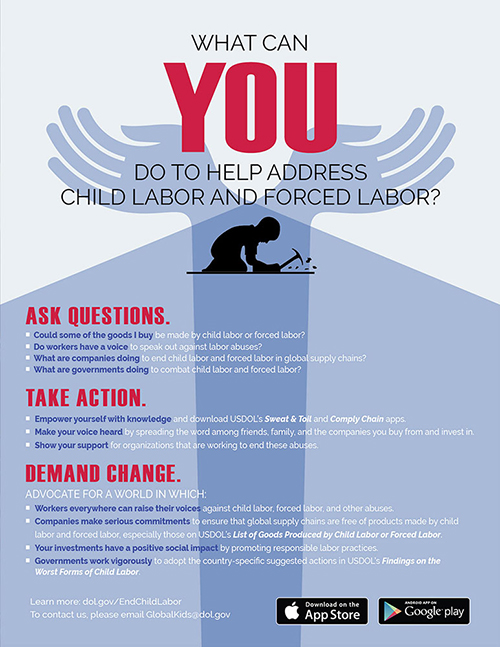List of Goods Produced by Child Labor or Forced Labor
The Bureau of International Labor Affairs (ILAB) maintains a list of goods and their source countries which it has reason to believe are produced by child labor or forced labor in violation of international standards, as required under the Trafficking Victims Protection Reauthorization Act (TVPRA) of 2005 and subsequent reauthorizations. The List of Goods Produced by Child Labor or Forced Labor comprises 159 goods from 78 countries and areas, as of September 28, 2022.
ILAB maintains the List primarily to raise public awareness about forced labor and child labor around the world and to promote efforts to combat them; it is not intended to be punitive, but rather to serve as a catalyst for more strategic and focused coordination and collaboration among those working to address these problems.
Publication of the List has resulted in new opportunities for ILAB to engage with foreign governments to combat forced labor and child labor. It is also a valuable resource for researchers, advocacy organizations and companies wishing to carry out risk assessments and engage in due diligence on labor rights in their supply chains.
The countries on the List span every region of the world. The most common agricultural goods listed are sugarcane, cotton, coffee, tobacco, cattle, rice, and fish. In the manufacturing sector, bricks, garments, textiles, footwear, carpets, and fireworks appear most frequently. In mined or quarried goods, gold, coal and diamonds are most common.
ILAB published the initial TVPRA List in 2009 and updated it annually through 2014, following a set of procedural guidelines that were the product of an intensive public consultation process. ILAB now updates and publishes the List every other year, pursuant to changes in the law.
Procedural Guidelines
On January 25, 2024, ILAB's Office of Child Labor, Forced Labor, and Human Trafficking published Procedural Guidelines for the development and maintenance of the List of Goods from countries produced by child labor or forced labor in violation of international standards.
| Country/Area | Good Sort ascending | Exploitation Type |
|---|---|---|
| Bangladesh | Child Labor | |
| Cambodia | Child Labor | |
| Niger | Child Labor | |
| Burma | Child Labor, Forced Labor | |
| Malaysia | There are reports that adults are forced to produce rubber gloves in Malaysia. Forced labor predominately occurs among migrant laborers from Bangladesh, India, Myanmar, and Nepal working in more than 100 rubber glove factories throughout Malaysia. Reports indicate that there are an estimated 42,500 migrant workers employed in the Malaysian rubber glove industry. Workers are frequently subject to high recruitment fees to secure employment that often keeps them in debt bondage; forced to work overtime in excess of the time allowed by Malaysian law; and work in factories where temperatures can reach dangerous levels. Additionally, laborers work under the threat of penalties, which include the withholding of wages, restricted movement, and the withholding of their identification documents. |
Forced Labor |
| Burma | There are reports that children as young as age nine are forced to work in the production of rubber in Burma. According to reports by NGOs, villagers, including children, are forced to work cultivating rubber plants in nurseries and on plantations for the military camps. Local officials and the military enforce the work orders. The forced child laborers are not paid for their work, and endure physical violence or other punishment if they refuse to work. |
Child Labor, Forced Labor |
| Cambodia | Child Labor | |
| Indonesia | Child Labor | |
| Liberia | Child Labor | |
| Philippines | Child Labor |
your hand? Download ILAB's Sweat & Toil App today!
Are you a company looking to fight child labor and forced labor in supply
chains?





